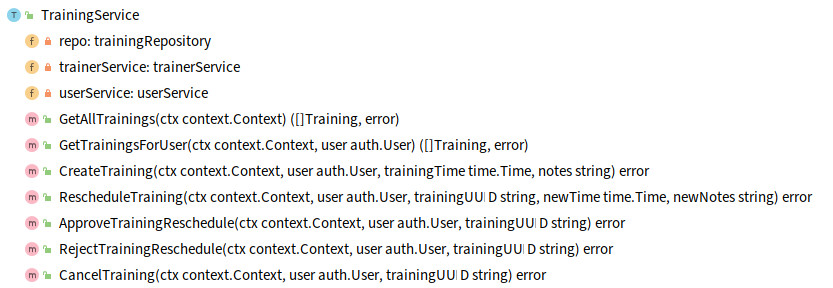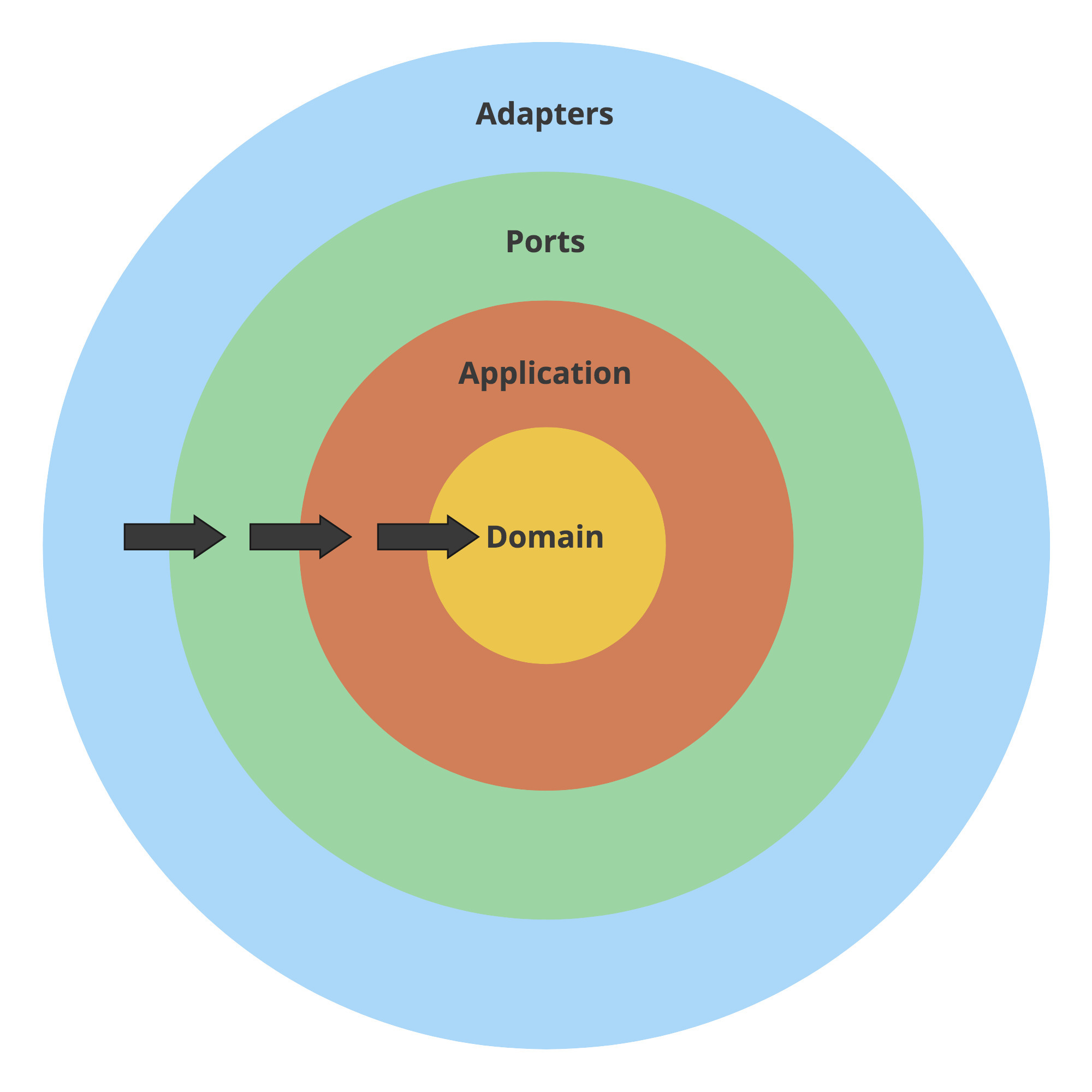combining ddd CQRS and clean architecture by refactoring a golang project
Abstract
You need to create your code in a way that will not block your future work by keeping constant development speed without destroying and touching existing code too much.
We build our domain with methods oriented on behaviours, not on data. Often, the domain logic is pretty stable after the initial development and can live unchanged for a long time.
In the previous articles, we introduced techniques like DDD Lite, CQRS, and Clean (Hexagonal) Architecture. Even if using them alone is beneficial, they work the best together. Like Power Rangers. Unfortunately, it is not easy to use them together in a real project. In this article, I will show you how to connect DDD Lite, CQRS, and Clean Architecture in the most pragmatic and efficient way.
Why should I care?
Working on a programming project is similar to planning and building a residential district. If you know that the district will be expanding in the near future, you need to keep space for future improvements. Even if at the beginning it may look like a waste of space. You should keep space for future facilities like residential blocks, hospitals, and temples. Without that, you will be forced to destroy buildings and streets to make space for new buildings. It’s much better to think about that earlier.

The situation is the same with the code. If you know that the project will be developed for longer than 1 month, you should keep the long term in mind from the beginning. You need to create your code in a way that will not block your future work. Even if at the beginning it may look like over-engineering and a lot of extra boilerplate, you need to keep in mind the long term.
It doesn’t mean that you need to plan every feature that you will implement in the future – it’s actually the opposite one. This approach helps to adapt to new requirements or changing understanding of our domain. Big up front design is not needed here. It’s critical in current times, when the world is changing really fast and who can’t adapt to these changes can get simply out of business.

This is exactly what these patterns give you when they are combined – the ability to keep constant development speed. Without destroying and touching existing code too much.
Does it require more thinking and planning? Is it a more challenging way? Do you need to have extra knowledge to do that? Sure! But the long term result is worth that! Fortunately, you are in the right place to learn that. 😉
But let’s leave the theory behind us. Let’s go to the code. In this article, we will skip reasonings for our design choices. We described these already in the previous articles. If you did not read them yet, I recommend doing it – you will understand this article better.
Like in previous articles, we will base our code on refactoring a real open-source project. This should make the examples more realistic and applicable to your projects.
Are you ready?
This is not just another article with random code snippets.
This post is part of a bigger series where we show how to build Go applications that are easy to develop, maintain, and fun to work with in the long term. We are doing it by sharing proven techniques based on many experiments we did with teams we lead and scientific research.
You can learn these patterns by building with us a fully functional example Go web application – Wild Workouts.
We did one thing differently – we included some subtle issues to the initial Wild Workouts implementation. Have we lost our minds to do that? Not yet. 😉 These issues are common for many Go projects. In the long term, these small issues become critical and stop adding new features.
It’s one of the essential skills of a senior or lead developer; you always need to keep long-term implications in mind.
We will fix them by refactoring Wild Workouts. In that way, you will quickly understand the techniques we share.
Do you know that feeling after reading an article about some technique and trying implement it only to be blocked by some issues skipped in the guide? Cutting these details makes articles shorter and increases page views, but this is not our goal. Our goal is to create content that provides enough know-how to apply presented techniques. If you did not read previous articles from the series yet, we highly recommend doing that.
We believe that in some areas, there are no shortcuts. If you want to build complex applications in a fast and efficient way, you need to spend some time learning that. If it was simple, we wouldn’t have large amounts of scary legacy code.
Here’s the full list of 14 articles released so far.
The full source code of Wild Workouts is available on GitHub. Don’t forget to leave a star for our project! ⭐
Let’s refactor
Let’s start our refactoring with the Domain-First approach. We will start with introduction of a domain layer. Thanks to that, we will be sure that implementation details do not affect our domain code. We can also put all our efforts into understanding the business problem. Not on writing boring database queries and API endpoints.
Domain-First approach works good for both rescue (refactoring 😉) and greenfield projects.
To start building my domain layer, I needed to identify what the application is actually doing. This article will focus on refactoring of trainings Wild Workouts microservice. I started with identifying use cases handled by the application. After previous refactoring to Clean Architecture, we can find it in the TrainingService. When I work with a messy application, I look at RPC and HTTP endpoints to find supported use cases.
One of functionalities that I identified is the approval of training reschedule. In Wild Workouts, a training reschedule approval is required if it was requested less than 24h before its date. If a reschedule is requested by the attendee, the approval needs to be done by the trainer. When it’s requested by the trainer, it needs to be accepted by the attendee.
- func (c TrainingService) ApproveTrainingReschedule(ctx context.Context, user auth.User, trainingUUID string) error {
- return c.repo.ApproveTrainingReschedule(ctx, trainingUUID, func(training Training) (Training, error) {
- if training.ProposedTime == nil {
- return Training{}, errors.New("training has no proposed time")
- }
- if training.MoveProposedBy == nil {
- return Training{}, errors.New("training has no MoveProposedBy")
- }
- if *training.MoveProposedBy == "trainer" && training.UserUUID != user.UUID {
- return Training{}, errors.Errorf("user '%s' cannot approve reschedule of user '%s'", user.UUID, training.UserUUID)
- }
- if *training.MoveProposedBy == user.Role {
- return Training{}, errors.New("reschedule cannot be accepted by requesting person")
- }
-
- training.Time = *training.ProposedTime
- training.ProposedTime = nil
-
- return training, nil
- })
- }Full source: github.com/ThreeDotsLabs/wild-workouts-go-ddd-example/commit/8d9274811559399461aa9f6bf3829316b8ddfb63
Start with the domain
Even if it doesn’t look like the worst code you’ve seen in your life, functions like ApproveTrainingReschedule tend to get more complex over time. More complex functions mean more potential bugs during future development.
It’s even more likely if we are new to the project, and we don’t have the “shaman knowledge” about it. You should always consider all the people who will work on the project after you, and make it resistant to be broken accidentally by them. That will help your project to not become the legacy that everybody is afraid to touch. You probably hate that feeling when you are new to the project, and you are afraid to touch anything to not break the system.
It’s not uncommon for people to change their job more often than every 2 years. That makes it even more critical for long-term project development.
If you don’t believe that this code may become complex, I recommend checking the Git history of the worst place in the project you work on. In most cases, that worst code started with “just a couple simple ifs”. 😉 The more complex the code will be, the more difficult it will be to simplify it later. We should be sensitive to emerging complexity and try to simplify it as soon as we can.
Training domain entity
During analyzing the current use cases handled by the trainings microservice, I found that they are all related to a training. It is pretty natural to create a Training type to handle these operations.

Methods of refactored TrainingService
noun == entity
Is it a valid approach to discover entities? Well, not really.
DDD provides tools that help us to model complex domains without guessing (Strategic DDD Patterns, Aggregates). We don’t want to guess how our aggregates look like – we want to have tools to discover them. Event Storming technique is extremely useful here… but it’s a topic for an entire separate article.
The topic is complex enough to have a couple articles about that. And this is what we will do shortly. 😉
Does it mean that you should not use these techniques without Strategic DDD Patterns? Of course not! The current approach can be good enough for simpler projects. Unfortunately (or fortunately 😉), not all projects are simple.
package training
// ...
type Training struct {
uuid string
userUUID string
userName string
time time.Time
notes string
proposedNewTime time.Time
moveProposedBy UserType
canceled bool
}Full source: github.com/ThreeDotsLabs/wild-workouts-go-ddd-example/internal/trainings/domain/training/training.go
All fields are private to provide encapsulation. This is critical to meet “always keep a valid state in the memory” rule from the article about DDD Lite.
Thanks to the validation in the constructor and encapsulated fields, we are sure that Training is always valid. Now, a person that doesn’t have any knowledge about the project is not able to use it in a wrong way.
The same rule applies to any methods provided by Training.
package training
func NewTraining(uuid string, userUUID string, userName string, trainingTime time.Time) (*Training, error) {
if uuid == "" {
return nil, errors.New("empty training uuid")
}
if userUUID == "" {
return nil, errors.New("empty userUUID")
}
if userName == "" {
return nil, errors.New("empty userName")
}
if trainingTime.IsZero() {
return nil, errors.New("zero training time")
}
return &Training{
uuid: uuid,
userUUID: userUUID,
userName: userName,
time: trainingTime,
}, nil
}Full source: github.com/ThreeDotsLabs/wild-workouts-go-ddd-example/internal/trainings/domain/training/training.go
Approve reschedule in the domain layer
As described in DDD Lite introduction, we build our domain with methods oriented on behaviours. Not on data. Let’s model ApproveReschedule on our domain entity.
package training
// ...s
func (t *Training) IsRescheduleProposed() bool {
return !t.moveProposedBy.IsZero() && !t.proposedNewTime.IsZero()
}
var ErrNoRescheduleRequested = errors.New("no training reschedule was requested yet")
func (t *Training) ApproveReschedule(userType UserType) error {
if !t.IsRescheduleProposed() {
return errors.WithStack(ErrNoRescheduleRequested)
}
if t.moveProposedBy == userType {
return errors.Errorf(
"trying to approve reschedule by the same user type which proposed reschedule (%s)",
userType.String(),
)
}
t.time = t.proposedNewTime
t.proposedNewTime = time.Time{}
t.moveProposedBy = UserType{}
return nil
}Full source: github.com/ThreeDotsLabs/wild-workouts-go-ddd-example/internal/trainings/domain/training/reschedule.go
If you had no chance to read:
I highly recommend checking them. It will help you understand this article better. They explain the decisions and techniques that we combine in this article.
Orchestrate with command
Now the application layer can be responsible only for the orchestration of the flow. There is no domain logic there. We hide the entire business complexity in the domain layer. This was exactly our goal.
For getting and saving a training, we use the Repository pattern.
package command
// ...
func (h ApproveTrainingRescheduleHandler) Handle(ctx context.Context, cmd ApproveTrainingReschedule) (err error) {
defer func() {
logs.LogCommandExecution("ApproveTrainingReschedule", cmd, err)
}()
return h.repo.UpdateTraining(
ctx,
cmd.TrainingUUID,
cmd.User,
func(ctx context.Context, tr *training.Training) (*training.Training, error) {
originalTrainingTime := tr.Time()
if err := tr.ApproveReschedule(cmd.User.Type()); err != nil {
return nil, err
}
err := h.trainerService.MoveTraining(ctx, tr.Time(), originalTrainingTime)
if err != nil {
return nil, err
}
return tr, nil
},
)
}Full source: github.com/ThreeDotsLabs/wild-workouts-go-ddd-example/internal/trainings/app/command/approve_training_reschedule.go
Refactoring of training cancelation
Let’s now take a look at CancelTraining from TrainingService.
The domain logic is simple there: you can cancel a training up to 24h before its date. If it’s less than 24h before the training, and you want to cancel it anyway:
- if you are the trainer, the attendee will have his training “back” plus one extra session (nobody likes to change plans on the same day!)
- if you are the attendee, you will lose this training
This is how the current implementation looks like:
- func (c TrainingService) CancelTraining(ctx context.Context, user auth.User, trainingUUID string) error {
- return c.repo.CancelTraining(ctx, trainingUUID, func(training Training) error {
- if user.Role != "trainer" && training.UserUUID != user.UUID {
- return errors.Errorf("user '%s' is trying to cancel training of user '%s'", user.UUID, training.UserUUID)
- }
-
- var trainingBalanceDelta int
- if training.CanBeCancelled() {
- // just give training back
- trainingBalanceDelta = 1
- } else {
- if user.Role == "trainer" {
- // 1 for cancelled training +1 fine for cancelling by trainer less than 24h before training
- trainingBalanceDelta = 2
- } else {
- // fine for cancelling less than 24h before training
- trainingBalanceDelta = 0
- }
- }
-
- if trainingBalanceDelta != 0 {
- err := c.userService.UpdateTrainingBalance(ctx, training.UserUUID, trainingBalanceDelta)
- if err != nil {
- return errors.Wrap(err, "unable to change trainings balance")
- }
- }
-
- err := c.trainerService.CancelTraining(ctx, training.Time)
- if err != nil {
- return errors.Wrap(err, "unable to cancel training")
- }
-
- return nil
- })
- }You can see some kind of “algorithm” for calculating training balance delta during cancelation. That’s not a good sign in the application layer.
Logic like this one should live in our domain layer. If you start to see some if’s related to logic in your application layer, you should think about how to move it to the domain layer. It will be easier to test and re-use in other places.
It may depend on the project, but often domain logic is pretty stable after the initial development and can live unchanged for a long time. It can survive moving between services, framework changes, library changes, and API changes. Thanks to that separation, we can do all these changes in a much safer and faster way.
Let’s decompose the CancelTraining method to multiple, separated pieces. That will allow us to test and change them independently.
First of all, we need to handle cancelation logic and marking Training as canceled.
package training
func (t Training) CanBeCanceledForFree() bool {
return t.time.Sub(time.Now()) >= time.Hour*24
}
var ErrTrainingAlreadyCanceled = errors.New("training is already canceled")
func (t *Training) Cancel() error {
if t.IsCanceled() {
return ErrTrainingAlreadyCanceled
}
t.canceled = true
return nil
}Full source: github.com/ThreeDotsLabs/wild-workouts-go-ddd-example/internal/trainings/domain/training/cancel.go
Nothing really complicated here. That’s good!
The second part that requires moving is the “algorithm” of calculating trainings balance after cancelation. In theory, we could put it to the Cancel() method, but IMO it would break the Single Responsibility Principle and CQS. And I like small functions.
But where to put it? Some object? A domain service? In some languages, like the one that starts with J and ends with ava, it would make sense. But in Go, it’s good enough to just create a simple function.
package training
// CancelBalanceDelta return trainings balance delta that should be adjusted after training cancelation.
func CancelBalanceDelta(tr Training, cancelingUserType UserType) int {
if tr.CanBeCanceledForFree() {
// just give training back
return 1
}
switch cancelingUserType {
case Trainer:
// 1 for cancelled training +1 "fine" for cancelling by trainer less than 24h before training
return 2
case Attendee:
// "fine" for cancelling less than 24h before training
return 0
default:
panic(fmt.Sprintf("not supported user type %s", cancelingUserType))
}
}Full source: github.com/ThreeDotsLabs/wild-workouts-go-ddd-example/internal/trainings/domain/training/cancel_balance.go
The code is now straightforward. I can imagine that I could sit with any non-technical person and go through this code to explain how it works.
What about tests? It may be a bit controversial, but IMO tests are redundant there. Test code would replicate the implementation of the function. Any change in the calculation algorithm will require copying the logic to the tests. I would not write a test there, but if you will sleep better at night – why not!
Don’t miss new posts. Subscribe to our newsletter!
Moving CancelTraining to command
Our domain is ready, so let’s now use it. We will do it in the same way as previously:
- getting the entity from the repository,
- orchestration of domain stuff,
- calling external
trainerservice to cancel the training (this service is the point of truth of “trainer’s calendar”), - returning entity to be saved in the database.
package command
// ...
func (h CancelTrainingHandler) Handle(ctx context.Context, cmd CancelTraining) (err error) {
defer func() {
logs.LogCommandExecution("CancelTrainingHandler", cmd, err)
}()
return h.repo.UpdateTraining(
ctx,
cmd.TrainingUUID,
cmd.User,
func(ctx context.Context, tr *training.Training) (*training.Training, error) {
if err := tr.Cancel(); err != nil {
return nil, err
}
if balanceDelta := training.CancelBalanceDelta(*tr, cmd.User.Type()); balanceDelta != 0 {
err := h.userService.UpdateTrainingBalance(ctx, tr.UserUUID(), balanceDelta)
if err != nil {
return nil, errors.Wrap(err, "unable to change trainings balance")
}
}
if err := h.trainerService.CancelTraining(ctx, tr.Time()); err != nil {
return nil, errors.Wrap(err, "unable to cancel training")
}
return tr, nil
},
)
}Full source: github.com/ThreeDotsLabs/wild-workouts-go-ddd-example/internal/trainings/app/command/cancel_training.go
Repository refactoring
The initial implementation of the repository was pretty tricky because of the custom method for every use case.
- type trainingRepository interface {
- FindTrainingsForUser(ctx context.Context, user auth.User) ([]Training, error)
- AllTrainings(ctx context.Context) ([]Training, error)
- CreateTraining(ctx context.Context, training Training, createFn func() error) error
- CancelTraining(ctx context.Context, trainingUUID string, deleteFn func(Training) error) error
- RescheduleTraining(ctx context.Context, trainingUUID string, newTime time.Time, updateFn func(Training) (Training, error)) error
- ApproveTrainingReschedule(ctx context.Context, trainingUUID string, updateFn func(Training) (Training, error)) error
- RejectTrainingReschedule(ctx context.Context, trainingUUID string, updateFn func(Training) (Training, error)) error
- }Thanks to introducing the training.Training entity, we can have a much simpler version, with one method for adding a new training and one for the update.
package training
// ...
type Repository interface {
AddTraining(ctx context.Context, tr *Training) error
GetTraining(ctx context.Context, trainingUUID string, user User) (*Training, error)
UpdateTraining(
ctx context.Context,
trainingUUID string,
user User,
updateFn func(ctx context.Context, tr *Training) (*Training, error),
) error
}Full source: github.com/ThreeDotsLabs/wild-workouts-go-ddd-example/internal/trainings/domain/training/repository.go
As in the previous article, we implemented our repository using Firestore. We will also use Firestore in the current implementation. Please keep in mind that this is an implementation detail – you can use any database you want. In the previous article, we have shown example implementations using different databases.
package adapters
// ...
func (r TrainingsFirestoreRepository) UpdateTraining(
ctx context.Context,
trainingUUID string,
user training.User,
updateFn func(ctx context.Context, tr *training.Training) (*training.Training, error),
) error {
trainingsCollection := r.trainingsCollection()
return r.firestoreClient.RunTransaction(ctx, func(ctx context.Context, tx *firestore.Transaction) error {
documentRef := trainingsCollection.Doc(trainingUUID)
firestoreTraining, err := tx.Get(documentRef)
if err != nil {
return errors.Wrap(err, "unable to get actual docs")
}
tr, err := r.unmarshalTraining(firestoreTraining)
if err != nil {
return err
}
if err := training.CanUserSeeTraining(user, *tr); err != nil {
return err
}
updatedTraining, err := updateFn(ctx, tr)
if err != nil {
return err
}
return tx.Set(documentRef, r.marshalTraining(updatedTraining))
})
}Full source: github.com/ThreeDotsLabs/wild-workouts-go-ddd-example/internal/trainings/adapters/trainings_firestore_repository.go
Connecting everything
How to use our code now? What about our ports layer? Thanks to the refactoring that Miłosz did in refactoring to Clean Architecture article, our ports layer is decoupled from other layers. That’s why, after this refactoring, it doesn’t require almost any significant changes. We just call the application command instead of the application service.

Clean/Hexagonal Architecture layers.
package ports
// ...
type HttpServer struct {
app app.Application
}
// ...
func (h HttpServer) CancelTraining(w http.ResponseWriter, r *http.Request) {
trainingUUID := r.Context().Value("trainingUUID").(string)
user, err := newDomainUserFromAuthUser(r.Context())
if err != nil {
httperr.RespondWithSlugError(err, w, r)
return
}
err = h.app.Commands.CancelTraining.Handle(r.Context(), command.CancelTraining{
TrainingUUID: trainingUUID,
User: user,
})
if err != nil {
httperr.RespondWithSlugError(err, w, r)
return
}
}Full source: github.com/ThreeDotsLabs/wild-workouts-go-ddd-example/internal/trainings/ports/http.go
How to approach such refactoring in a real project?
It may not be obvious how to do such refactoring in a real project. It’s hard to do a code review and agree on the team level on the refactoring direction.
From my experience, the best approach is Pair or Mob programming. Even if, at the beginning, you may feel that it is a waste of time, the knowledge sharing and instant review will save a lot of time in the future. Thanks to great knowledge sharing, you can work much faster after the initial project or refactoring phase.
In this case, you should not consider the time lost for Mob/Pair programming. You should consider the time that you may lose because of not doing it. It will also help you finish the refactoring much faster because you will not need to wait for the decisions. You can agree on them immediately.
Mob and pair programming also work perfectly while implementing complex, greenfield projects. Knowledge sharing is especially important investment in that case. I’ve seen multiple times how this approach allowed to go very fast in the project in the long term.
When you are doing refactoring, it’s also critical to agree on reasonable timeboxes. And keep them. You can quickly lose your stakeholders’ trust when you spend an entire month on refactoring, and the improvement is not visible. It is also critical to integrate and deploy your refactoring as fast as you can. Perfectly, on a daily basis (if you can do it for non-refactoring work, I’m sure that you can do it for refactoring as well!). If your changes stay unmerged and undeployed for a longer time, it will increase the chance of breaking functionalities. It will also block any work in the refactored service or make changes harder to merge (it is not always possible to stop all other development around).
But when to know if the project is complex enough to use mob programming? Unfortunately, there is no magic formula for that. But there are questions that you should ask yourself:
- do we understand the domain?
- do we know how to implement that?
- will it end up with a monstrous pull request that nobody will be able to review?
- can we risk worse knowledge sharing while not doing mob/pair programming?
Summary
And we come to an end. 😄
The entire diff for the refactoring is available on our Wild Workouts GitHub (watch out, it’s huge!).
If you had no chance to read previous articles yet, you know what to do! Even if some of the used approaches are simplified, you should already be able to use them in your project and see value from them.
I hope that after this article, you also see how all introduced patterns are working nicely together. If not yet, don’t worry. It took me 3 years to connect all the dots. But it was worth the time spent. After I understood how everything is connected, I started to look at new projects in a totally different way. It allowed me and my teams to work more efficiently in the long-term.
It is also important to mention, that as all techniques, this combination is not a silver bullet. If you are creating project that is not complex and will be not touched any time soon after 1 month of development, probably it’s enough to put everything to one main package. 😉 Just keep in mind, when this 1 month of development will become one year!
We will also continue these topics in the next articles. We will be shortly drifting to Strategic DDD Patterns, which should also help you gain a more high-level perspective on your projects.
Did this article help you to understand how to connect DDD, Clean Architecture, and CQRS? Is something still not clear? Please let us know in the comments! We are happy to discuss all your doubts!